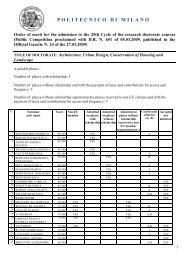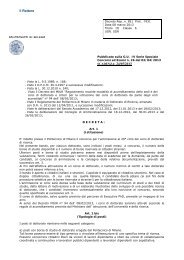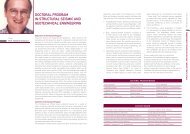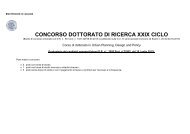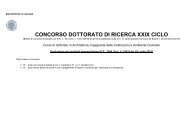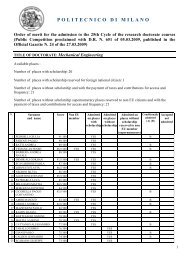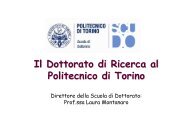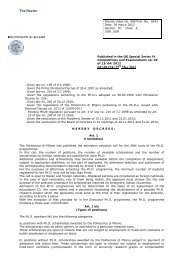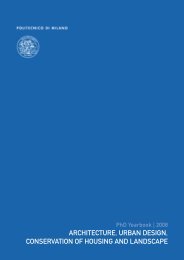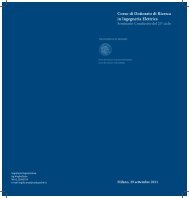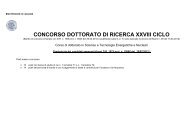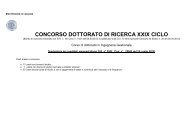design and technologies for cultural heritages | electrical engineering
design and technologies for cultural heritages | electrical engineering
design and technologies for cultural heritages | electrical engineering
You also want an ePaper? Increase the reach of your titles
YUMPU automatically turns print PDFs into web optimized ePapers that Google loves.
DESIGN AND TECHNOLOGIES FOR CULTURALHERITAGES | ELECTRICAL ENGINEERING | ENERGY |GEOMATICS AND INFRASTRUCTURES | INDUSTRIALCHEMISTRY AND CHEMICAL ENGINEERING |INDUSTRIAL DESIGN AND MULTIMEDIACOMMUNICATION | INFORMATION TECHNOLOGY |INTERIOR DESIGN | MANAGEMENT, ECONOMICSAND INDUSTRIAL ENGINEERING | MANUFACTURINGAND PRODUCTION SYSTEMS | MATERIALSENGINEERING | MATHEMATICAL MODELS ANDMETHODS IN ENGINEERING | MECHANICALSYSTEMS ENGINEERING | PHYSICS | PRESERVATIONOF ARCHITECTURAL HERITAGE | PROGRAMMING,MAINTENANCE, REHABILITATION OF THE BUILDINGAND URBAN SYSTEMS | RADIATION SCIENCE ANDTECHNOLOGY | Rotary Wing Aircraft | SANITARY- ENVIRONMENTAL ENGINEERING | STRUCTURALSEISMIC AND GEOTECHNICAL ENGINEERING |TECHNOLOGY AND DESIGN FOR ENVIRONMENTALQUALITY IN BUILDINGS AND URBAN CONTEXT |TERRITORIAL DESIGN AND GOVERNEMENT | URBANAND ARCHITECTURAL DESIGN | Virtual Prototypes<strong>and</strong> Real Products | WATER ENGINEERING |AEROSPACE ENGINEERING | ARCHITECTURALCOMPOSITION | ARCHITECTURE, URBAN DESIGN,CONSERVATION OF HOUSING AND LANDSCAPE |BIOENGINEERING | BUILDING ENGINEERING PhD Yearbook | 2010
Chair:Prof. Valerio Di BattistaDOCTORAL PROGRAMIN PROGRAMMING, MAINTENANCE,REHABILITATION OF THE BUILDINGAND URBAN SYSTEMSThe DL aims at training researchers, managers, <strong>and</strong> <strong>design</strong>professionals being able to set out innovative <strong>design</strong> strategiesof organization, management, maintenance, rehabilitation, <strong>and</strong>programming of the building facilities as well as to promote <strong>and</strong>co-ordinate in this specific field high qualification research activities,projects, programs, <strong>and</strong> controls in compliance with the newEuropean Union regulatory procedural <strong>and</strong> technical context <strong>and</strong>with the subsequent future developments of the relevant operativecontext <strong>and</strong> sector market.The building sector is experiencing important reconversions in thewhole cognitive, decision-making, <strong>design</strong>ing, constructive, control,<strong>and</strong> managing process as well as in the attention paid to buildingfacilities.Such changes depend on various factors.∙∙International factors: the dem<strong>and</strong> of greater businessescompetitiveness <strong>and</strong> of strong services enhancement (in<strong>for</strong>mationsystems, assessments, complex <strong>design</strong>s, controls, etc.);∙∙National factors: the new subjects, the increasing investmentin buildings, the adaptation to the new regulations (ISO, CEN,Public Works, UNI, etc.), the new quality <strong>and</strong> building facilitiesmanagement dem<strong>and</strong>.The doctorate deals with the management of buildings, fromcomplex housing systems to the building organizations, in theframework of technical <strong>and</strong> economical special features <strong>and</strong> in the<strong>cultural</strong> <strong>and</strong> social implications.In particular, the doctorate provides <strong>for</strong> training <strong>for</strong> research in thethree main fields: planning, rehabilitation, <strong>and</strong> maintenance alongthe whole process <strong>and</strong> in the main scales.The doctorate, in the preliminary training phase, provides <strong>for</strong> theteaching of topics that are usually absent in the current curricula <strong>for</strong>graduation as well as of research methods.Basic training give a wide range of updated knowledge <strong>and</strong> ofspecific rehabilitation processes procedures <strong>and</strong> management onthe different scales.It will be possible to carry out research both on a theoreticalmethodologicallevel <strong>and</strong> on an experimental level <strong>and</strong> all theinteractions between differing interests that can spur processinnovations will be promoted.Theoretical <strong>and</strong> applicative research will mainly be targeted to thedevelopment of service activities at all public <strong>and</strong> private structureswhich intervene in the various steps of building <strong>and</strong> urban systemsplanning, rehabilitation, maintenance, <strong>and</strong> management processes.The professional profiles cater to highqualification service structures as well as to Publicadministrators, building facilities managementcompanies, <strong>engineering</strong> <strong>and</strong> <strong>design</strong>ingcompanies, building companies <strong>and</strong> variousnature professional activities being relevant to thebuilding.Specialist training is developed along thefollowing curricula:∙∙urban rehabilitation <strong>and</strong> public works complexinterventions integrated projects;∙∙rehabilitation <strong>and</strong> reuse of complex buildings;∙∙maintenance of building facilities.Every curriculum will include investigation topics<strong>and</strong> theses hypotheses being closely related toalready started research or research in advancedstatus of starting.Such curricula pertain to problems <strong>and</strong>theoretical/applicative research of most scientificWaldemar Albretti (Talento Consulting)Franco Guidi (Lombardini 22)Favalli Maurizio (Costruire)GianS<strong>and</strong>ro Barzaghi (Provincia di Milano)Luigi V. Mangano (Mangano & Partners)Advisory BoardScholarship Sponsorsinterest <strong>and</strong> social relevance which suggesthowever many investigation <strong>and</strong> application fieldsthat are still uncovered.The theses are suggested by the academic staff inthe frame of carried out research.The theses are discussed <strong>and</strong> checked at the seatof the Reference Committee <strong>and</strong> concern specificaspects of the considered problems selected bythe students.The thesis proposal is <strong>for</strong>mulated in the secondsemester of the first year.The theses are drawn by continuously interactingwith the possible external partners or with thepeople involved in the operative activities thatcorrespond to the studied topicsThe theses developed from PhD students untilnow (20) were original, always written with thecontribution of Public or private Corporations <strong>and</strong>introduced innovations to the building process.Stefano Marrannini (Comune di Milano)Silvia Risso (Regione Liguria)Giampaolo Artoni (Legambiente)Bruno Rossetti (Weber&Broutin)Dipartimento BEST“Evoluzione e tras<strong>for</strong>mazione del tempo libero. Gli spazi lucidi e per il fitness <strong>and</strong> leisure:aspetti urbanistici, gestionali e strategie d’investimento”Fondo per il sostegno dei giovani e per favorire la mobilità degli studenti“Risparmio energetico e microgenerazione distribuita”PROGRAMMING, MAINTENANCE, REHABILITATION OF THE BUILDING AND URBAN SYSTEMS PhD Yearbook | 2010477
478Managing change in the World CulturalHeritage sitesPlans, achievements <strong>and</strong> perspectives<strong>for</strong> the industrial heritageMaria Paola BorgarinoThe research deals with heritagemanagement, <strong>and</strong> verifies thecurrent state of implementation,the opportunities <strong>and</strong> limitsof the UNESCO ManagementPlan. The study, which firstlyaims to illustrate the state ofthe art, describes the scenery(achievements, occurredconflicts, models, references,regulations, guidelines, …)<strong>and</strong> proposes some trendlines.As second step, the researchstresses the relationshipbetween the inscription, thedrafting process <strong>and</strong> thefollowing implementation ofthe management strategy insome significant case study,in order to outline, <strong>for</strong> eachapproach, benefits, criticalities<strong>and</strong> improvements. The researchis composed of three phases.The aim of the first stage(analysis) was to acquire models,references <strong>and</strong> plans alreadyavailable, whereas in secondstage (comparison) mail issues<strong>and</strong> themes were defined, inorder to set up the third phases(assessment), which includesthe networking <strong>and</strong> the testingstage.UNESCO requires a managementplan since 1997, as part ofthe domination dossier <strong>for</strong>the inscription of the sites inthe World Heritage List, <strong>and</strong>the “Operational Guidelines<strong>for</strong> the Implementation of theWorld Heritage Convention”,issued in 1977 <strong>and</strong> updatedsince 2008, specifies the basiccontents of the plan. First of all,the “Operational guidelines”state that the managementplan should specify how theoutst<strong>and</strong>ing universal value ofthe inscribed property shouldbe preserved <strong>and</strong> involves acycle of long-term <strong>and</strong> dailyactivities to protect, conserve<strong>and</strong> present the site. Then, thetext specifies that managementstrategy depends on the type,characteristics <strong>and</strong> needs of theproperty <strong>and</strong> its <strong>cultural</strong> <strong>and</strong>environmental context.However, the most frequentlyused strategies seems to belacking, limited <strong>and</strong> evencounterproductive <strong>for</strong> theconservation of the materialauthenticity of the site, <strong>and</strong>,when management planbecomes into practice, this toolshardly contribute to achievea long- term sustainability.We can easily state that, sinceusually management plans focuson tourism <strong>and</strong> incentive therestoration of the charactersof the site, the inscriptionoften constitutes an uncertaingain <strong>for</strong> the <strong>cultural</strong> heritage,over- restored <strong>and</strong> recreatedas a film set, <strong>and</strong> can be evenmore dangerous <strong>for</strong> the localcommunity, which becomeinactive spectator of an fakedevelopment.In spite of the partiality of theoutcomes, management planscan be still regarded as essentialtools to merge conservation withreasonable trans<strong>for</strong>mations <strong>and</strong>coordinate different interests<strong>and</strong> actions, <strong>and</strong>, accordingto the latest theoreticalcontributions, through theplan the site can move towarda evolutionary <strong>and</strong> mostchallenging perspective, wherea well-<strong>design</strong>ed managementprocess supports shared rules<strong>and</strong> aids skill enhancement. Inthe comprehensive frameworkrequired in management plan,conservation can engage anactive role, <strong>and</strong> sustains a moreadvanced vision, where carereplaces cure, <strong>and</strong> enhancementmatches with conservationin a continuous reciprocalimprovement of knowledge <strong>and</strong>skills.Besides, management plansseems to be increasinglyinadequate in managing theconflicts arising from a moreinclusive notion of heritage <strong>and</strong>,in recent years, the increasedcomplexity of the inscribedsites, main consequence of the“Global Strategy <strong>for</strong> a Balanced,Representative <strong>and</strong> CredibleWorld Heritage List” launchedby the Comittee in 1994, gaverise to the development of newreferences. In addition, originalmanagement approaches havebeen implemented outside thelist. Have the new referencesreally given us effective tools toaddress the critical issues arisingfrom enlargement of the list?What can we learn from theother management experiences?The plans devised <strong>for</strong> thecompany town (Derwent VallleyMills, New Lanark, Saltaire),industrial cities (La Chaux-de-Fonds / Le Locle, watchmakingtown planning) <strong>and</strong> modernurban estates (Berlin ModernismHousing Estates) inscribed in thelast decade <strong>and</strong> the experiencesled in Carbonia, Ivrea, Bat’ovany-Partizánske, Sunila <strong>and</strong> Lyonseemed to be a good viewpoint<strong>for</strong> underst<strong>and</strong>ing the presentmanagement issues, that arisein a extended <strong>and</strong> dynamicframework, where the plan haveto deal with changing needs <strong>and</strong>the site manager have to <strong>for</strong>eseedifferent degrees of involvement,because of the extent of theinscribed areas <strong>and</strong> because ofthe hostility that this heritage stillarouse.The international seminar“Experiences in heritagemanagement trans<strong>for</strong>mation.Company towns in Europe”(Politecnico di Milano, 14- 15May 2009) was organized inthe third stage, in order to pointout some international bestpractices in built <strong>cultural</strong> heritageregulation <strong>and</strong> management. Theselected case studies (Carbonia,Ivrea, Crespi D’Adda, DerwentValley Mills, the housing estatesin the Berlin Modern Style,Sunila, Bellevue- Bellavista)presented different managementstrategies in order to underst<strong>and</strong>how to deal with different kindof stakeholders (private owners,users, companies…), needs <strong>and</strong>1. Berlin Modernism Housing Estates 2. Crespi d’Addapolicies. Trough the presentationof some advanced case studiesin Europe, the seminar aimed toshare the experiences about thecompany town already in theUNESCO WHL or provided withsignificant management tools.The establishment of the in<strong>for</strong>malnetwork on <strong>cultural</strong> heritagemanagement was the mainoutcome of the seminar.A significant problem setting<strong>for</strong> the management issuescan be carried out looking atCrespi d’Adda, the UNESCO siteinscribed in the World HeritageList in 1995 <strong>and</strong> still devoid of theplan, which was the main casestudy of the research. The Italiancompany town which was themain case study of the research,summarizes the most recurringcriticalities, such as the reuse ofthe huge sheds, the obsolescenceof the residential buildings<strong>and</strong> the lack of public services.Moreover, the inhabitants seemsto have an ambivalent feelingregarding the inscription: is thelabel a award or a burden? Canthe plan allow trans<strong>for</strong>mation?Facades are a huge deal <strong>for</strong> thesite, because in many cases,material genuiness is alreadycompromise, despite themaintenance of the characters. Insome cases, the new surfaces areestablished <strong>and</strong> functional, <strong>and</strong>it may be acknowledged that isnot easy to repurpose “original”materials, because of currentneeds <strong>and</strong> per<strong>for</strong>mances.The management plan that iscurrently being <strong>for</strong>med sustainsthe development of technicalrules <strong>for</strong> the conservation <strong>and</strong>trans<strong>for</strong>mation of the builtheritage, based on sharedcriteria, in order to controltrans<strong>for</strong>mations of public <strong>and</strong>private properties avoidingboth, unadvised renewal <strong>and</strong>ordinary reconstruction. Proposedpolicy concerns maintenance<strong>and</strong> trans<strong>for</strong>mation of dwellingsurfaces (as plaster, basement,fastening), supporting <strong>design</strong>er ina justified, conscious <strong>and</strong> awareapproach. Technical rules avoidany imposition <strong>and</strong> suggestsrules based on environmentalcompatibility, knowledge, <strong>and</strong>diagnostics.PROGRAMMING, MAINTENANCE, REHABILITATION OF THE BUILDING AND URBAN SYSTEMS PhD Yearbook | 2010479
480ENVIRONMENT AND ENERGY IN HOSPITALAndrea BrioschiThe research moves fromthe current global <strong>and</strong> localcontext <strong>and</strong> from shareddevelopment strategies. Fromthe observation <strong>and</strong> the analysisof contemporary environmental<strong>and</strong> energy issues <strong>and</strong> fromredefined directions ofgrowth of human activity, itis addressing the question ofenvironmental sustainability <strong>and</strong>energy conservation of buildingsystems <strong>and</strong> urban hospitals.The thesis is articulated intotwo different <strong>and</strong> sequentialresearch methodologiesthrough a first analysis of atheoretical-interpretive <strong>and</strong>a subsequent field survey. Asa result of the research <strong>and</strong>interpretation of documents,a framework <strong>and</strong> a scientificstate of the art <strong>and</strong> innovativestrategies <strong>and</strong> technology<strong>design</strong> have been created.In the final phase has beendeveloped a field surveyrelating the specific topic ofenergy saving <strong>and</strong> efficiencyof the Park Hospital in theLombardy Region. This has beenarticulated in a diagnosis oftechnological <strong>and</strong> efficiency ofregional hospitals, implementedthrough a census, <strong>and</strong> in asubsequent identificationof interventional cases, inorder to show its economic,environmental <strong>and</strong> healthper<strong>for</strong>mance of the energyefficiency consumption <strong>and</strong> ofthe environmentally sound.The environmental context isthe primary factor determiningthe quality of life, welfare <strong>and</strong>the onset of human disease.The World Health Organizationestimates that 25-33% ofdiseases affecting the globalpopulation are determined byenvironmental factors. A humanactivity indifferent to impacts,through the uncontrolledexploitation of l<strong>and</strong> <strong>and</strong>depletable energy resources,constitutes a continuingthreat to human health <strong>and</strong>causes significant healthproblems. Climate changes<strong>and</strong> air pollution are some ofthe effects of such a growthprocess. Consider that the WHOestimates a mortality incidenceabout 240,000 deaths a year inthe European urban area due toexcessive air pollutant emissions.Within this scenario has beenoutlined the knowledge thatthe conventional hospital“productivist”, understood as “amachine <strong>for</strong> healing” indifferentto the environment <strong>and</strong> energy,is a place of production of healthbut also of disease. The Agency<strong>for</strong> Environmental Protection inthe United States has estimatedthat the American health caresector is among the most energyconsumer of business sector <strong>and</strong>that the power consumption isdue to the indirect health costsof 600 million dollars a year <strong>for</strong>care of diseases induced <strong>and</strong>exacerbated by pollutants. So,to honor the total commitmentto the entire society is necessaryto per<strong>for</strong>m a redefinitionof the hospital through anextensive trans<strong>for</strong>mation of theconstruction processes directedtowards the welfare of thenature <strong>and</strong> men. With a carefuldevelopment of environment<strong>and</strong> energy, the hospital can bean overall paradigm of health <strong>for</strong>other human practices <strong>and</strong> it cancarry out its vocation.The first phase of a theoreticalinterpretivebegins with anintroductory chapter illustratingthe close <strong>and</strong> inseparableconnection between health<strong>and</strong> environment <strong>and</strong> developsan overview of the state ofthe art in four sequentialchapters that address the <strong>design</strong>process building hospital, theintegration <strong>and</strong> the impact onthe site, the energy use, theenvironmental quality <strong>and</strong> thetrans<strong>for</strong>mation of architecturallanguage. The introductiondescribes the changing conceptof health, with the transitionfrom thinking of classicalmedicine to biomedical modelbio-psycho-social consideringthe relationship with theenvironment, <strong>and</strong> shows howhuman activities may constitutea decisive risk factor <strong>for</strong> thewelfare of nature <strong>and</strong> <strong>for</strong> man.The following chapter willaddress the first technologicalissue with a synthetic frameworkof the integrated process ofhospital <strong>design</strong>. Starting fromthe integral management of theproject <strong>and</strong> from many energy<strong>and</strong> environmental aspects themain application tools BuildingIn<strong>for</strong>mation Modeling or GreenGuide <strong>for</strong> Health Care havebeen identified. In the thirdchapter, have been investigatedthe criteria of settlement, theenvironmental impacts <strong>and</strong>integration in the territory.Evaluation of l<strong>and</strong> use <strong>and</strong>production of pollutant loadshave been associated with thequality of spaces <strong>and</strong> services,the organization of transport<strong>and</strong> h<strong>and</strong>ling of food. Thecentral part of the analysishas been reserved <strong>for</strong> the use<strong>and</strong> production of energy inhospitals. A first survey aboutthe incidence of consumptionof the social-health sector,has been followed by a periodillustrating the characteristicsof the hospital building systems<strong>and</strong> a summary of operationsmanagement <strong>and</strong> technology <strong>for</strong>efficient energy use. This issueends with the reconstruction ofexisting development strategiesin Europe <strong>and</strong> Italy, with theanalysis of the project “EnergyConscious European Hospitals<strong>and</strong> Health Care Buildings”<strong>and</strong> the various Italian regionalexperience. The fifth chapterconcludes the phase of gradingthe state of the art with thedescription of the criteria ofenvironmental quality <strong>and</strong> thetrans<strong>for</strong>mations of architecturallanguages of the hospital inrelation with the changedrelationship with the naturalenvironment.This phase has been a timeof development <strong>and</strong> transferknowledge of a disciplinary field,almost neglected in Italy butbecoming more prominent <strong>and</strong>important in international realityidentifying the most innovativestrategies <strong>and</strong> <strong>technologies</strong>currently in use within thehospital projects. The analysiscould provide an appropriatetheoretical <strong>and</strong> interpretiveframework <strong>for</strong> defining criteria<strong>and</strong> <strong>design</strong> tools, <strong>and</strong> disclosureof illustrative documents, usefulto industry engineers <strong>and</strong> publicadministrations.In the second phase, <strong>for</strong> theconstruction of a preliminarytechnological diagnosis, plant<strong>engineering</strong> <strong>and</strong> energy ofhospitals around the country,a field survey of the ParkHospital in the Region ofLombardy has been developed.The cognitive process startedwith the dissemination <strong>and</strong>compilation of checklists aimedat all businesses, the subsequentanalysis <strong>and</strong> interpretation ofdata <strong>and</strong> the final phase ofidentifying critical issues <strong>and</strong>pre-planning intervention. Thesample covered 32% of the102 regional hospitals involved.The questionnaires have beenstructured in four thematicareas concerning the energymanager, the structural aspects,the management <strong>and</strong> the energyconsumption. After havinggathered checklists, a summaryhas been prepared illustratingthe data, with the constructionof graphs <strong>and</strong> tables, <strong>and</strong> aninterpretive analysis has beencarried out with the definitionof parametric indices. In thefinal part have been highlightedthe weaknesses of the currentstate of the park hospital, <strong>and</strong>an environmental <strong>and</strong> healthimpact has been estimated<strong>and</strong> <strong>for</strong> improvement optionshave been advanced. This partrepresents an input appliedto the entire research path,confirming the theory <strong>and</strong>demonstrate the real scientificvalue, <strong>and</strong> results, in a first step,in a process of environmentalassessment <strong>and</strong> spatial planning<strong>for</strong> the reorganization ofenergy management hospitals.The survey has generated anunpublished database <strong>and</strong> itmay be a preliminary technicalframework, useful to theLombardy Region to implementthe strategic considerations <strong>and</strong>possible intervention programs.PROGRAMMING, MAINTENANCE, REHABILITATION OF THE BUILDING AND URBAN SYSTEMS PhD Yearbook | 2010481
482High efficiency distributed generationsystems in urban districtsMassimiliano ManfrenThe path towards energysustainability is commonlyreferred to as the incrementaladoption of available<strong>technologies</strong>, practices <strong>and</strong>policies that may help todecrease the environmentalimpact of energy sector, whileproviding an adequate st<strong>and</strong>ardof services. The increasedawareness, that ”addressingclimate change <strong>and</strong> the activitiescausing climate change is akey challenge <strong>for</strong> the 21stcentury, <strong>for</strong> both developed<strong>and</strong> developing countries, ifsustainable development is tobe attained”, as stated by theEuropean Environment Agencyin 2002, <strong>and</strong> EU 2020 EmissionReduction Plan are clear signalsin this direction.The recent development ofefficient <strong>technologies</strong> <strong>for</strong>distributed generation ischanging the focus of theproduction of electricity fromcentralized power plants to localgeneration units spread over theterritory. The evaluation of tradeoffsbetween <strong>technologies</strong>,practices <strong>and</strong> policies <strong>for</strong> themitigation of environmentalproblems related to energyresources depletion requiresdeep knowledge of the local <strong>and</strong>global effects of the proposedsolutions. The increasingly globalnature of contemporary societyhas determined a strongerinterconnection between humanactivities, energy use <strong>and</strong>pollution reduction strategies<strong>and</strong> so these topics must benecessarily addressed.Exploration of possiblealternatives in energy systemswith accounting, simulation <strong>and</strong>optimization tools is essentialto enable transparent decisionmaking process, based onscientific criteria. This processis intrinsically multiobjectivebecause the task is either tomaximize or minimize severalconflicting objects. Whenplanning distributed generation<strong>technologies</strong> adoption, the bestcompromise between cost ofenergy services, global emissions(CO 2) <strong>and</strong> local pollutantsemissions (NO x, SO x, PM, etc.)has to be found, because apotential deregulated shift fromcentral to distributed powergeneration may decrease localair quality.A methodological approachthat integrates differentcomputational models <strong>and</strong>techniques is needed toenable an effective energy <strong>and</strong>distributed generation planningin the urban built environment.Accounting tools, simulationtools <strong>and</strong> soft computingtechniques have to be combinedin order to obtain a correctvision of which are the current<strong>and</strong> future perspectives <strong>for</strong>communities. On the other h<strong>and</strong>the evaluation of energetic,economic <strong>and</strong> environmentaltrade-offs between differentoptions in environmentalresponsible community planningis essential <strong>and</strong> data mustbe visualized not only fromstakeholders <strong>and</strong> decisionmakers, but also from citizensto allow a better participation.In this sense, transparent <strong>and</strong>efficient methodologies <strong>and</strong>computational techniques haveto be employed in combinationwith adequate scientific datarepresentation.In recent years major advanceshave been made in thedevelopment of computationaltools to solve coupled simulation<strong>and</strong> optimization problems.Evolutionary computationhas been found to be veryrobust in solving this kindof problems, but a detailedsimulation <strong>and</strong> optimizationapproach is too computationallyintensive to be accessiblewithout expert knowledge<strong>and</strong> adequate hardware <strong>and</strong>software resources. Explorationof possible <strong>design</strong> optionsbecomes an issue when dealingwith the optimization of a largesystem. Additionally, scalabilityof DG <strong>technologies</strong> ensuresthe possibility to find solutionstailored on specific needs butrequires the correct evaluationof possible <strong>design</strong> options.For these reasons a syntheticapproach is proposed in thisresearch work.The methodology <strong>and</strong> thesimulation/optimization modeldeveloped starts from thecollection of time-series of data.The methodology accounts <strong>for</strong>the specific characteristics ofthe site in which technologyimplementation is considered:data are extracted from aGIS application via spatialanalysis, integrated with others(climatic data, demographicdata, economic growth, etc.)<strong>and</strong> categorized <strong>for</strong> energydem<strong>and</strong> <strong>and</strong> load prediction,which is per<strong>for</strong>med via neuralnetworks (nonlinear regression).Soft computing techniques arepreferred to traditional modelingapproaches because they donot require a strict hierarchicalproblem definition.Load data, as well as technologydata <strong>and</strong> economic parameters(utility tariffs, <strong>technologies</strong> initialinvestment cost, <strong>technologies</strong>operation <strong>and</strong> maintenancecost, etc.), represents inputs<strong>for</strong> a two level optimizationprocedure, <strong>for</strong> solving plantsizing <strong>and</strong> economic dispatchproblems. The optimization ismultiobjective, considering asobject functions annualizedcost (economic impact), C0 2emission (global environmentalimpact) <strong>and</strong> NO xemission (localenvironmental impact). Thecalculation is per<strong>for</strong>med via amultiobjective genetic algorithm.The use of advanced analysistechniques aims to obtain adeeper underst<strong>and</strong>ing of theproblem to be solved.The proposed methodology<strong>and</strong> model are applied in theselected case studies whichare portions of the Parmaurban territory. Essential datahave been collected withinthe collaboration activity withParma Energy Agency <strong>for</strong> therevision of the city energy plan<strong>and</strong> <strong>for</strong> the <strong>for</strong>mulation of aninnovative local building energyregulation. The validationof the proposed model isper<strong>for</strong>med by employing realdata <strong>and</strong> currently availabledistributed generationmodels. The scope beyondthis research is to promotethe development processtowards the new paradigm ofdistributed generation. Thisprocess must be supported bypublic administrations throughenergy regulations, HVACsystems control <strong>and</strong> monitoringcampaigns, incentives <strong>for</strong> goodpractices, etc. These actionsaim to set adequate boundaryconditions <strong>for</strong> the applicationof innovative solutions <strong>and</strong>knowledge transfer. Publicadministration task is toundertake actions to permitthe participation of citizens<strong>and</strong> private investors to therenovation process, whilecreating at the same time jobopportunities <strong>and</strong> developmentof the local energy servicessector.PROGRAMMING, MAINTENANCE, REHABILITATION OF THE BUILDING AND URBAN SYSTEMS PhD Yearbook | 2010483
484LANDSCAPE AND LOCAL DEVELOPMENT:INDUCING EVOLUTIONARY BEHAVIOURSFrancesca PutignanoThe present research aims toinvestigate which role couldplay the l<strong>and</strong>scape in localdevelopment, with regard notonly to material <strong>and</strong> economicaspects, but also <strong>and</strong> especially tothe intangible <strong>and</strong> cognitive ones.The theoretical framework, <strong>and</strong>more recently, institutional <strong>and</strong>normative assets have adopteda less <strong>and</strong> less restrictive conceptof <strong>cultural</strong> heritage. At Europeanlevel such process led to theelaboration of the EuropeanL<strong>and</strong>scape Convention,that extends the conceptof l<strong>and</strong>scape to the wholeterritory, while previously it wastied, by the various Countrieslegislative traditions, to selectiveconceptions. It confirms theneed to globally face the topicof quality in all the populatedareas, recognized as an essentialcondition <strong>for</strong> individual <strong>and</strong>social welfare, <strong>for</strong> a sustainabledevelopment <strong>and</strong> as a resourcethat favours economic activities.By defining l<strong>and</strong>scape as “anarea, as perceived by people,whose character is the result ofthe action <strong>and</strong> interaction ofnatural <strong>and</strong>/or human factors”(Article 1), the EuropeanL<strong>and</strong>scape Convention givesa key role to the population’sperception of its environment.It implies recognition of therights <strong>and</strong> the responsibilitiesof populations to play an activerole in the processes of acquiringknowledge, taking decisions<strong>and</strong> managing the quality of theplaces where they live. Publicinvolvement is regarded not as a<strong>for</strong>mal act but as an integral partof management, protection <strong>and</strong>planning procedures.The main focus of the presentresearch is that perceptionshould become the mosteffective innovation factor <strong>for</strong>tools <strong>and</strong> procedures, accordingto an idea of l<strong>and</strong>scape asa co-evolving system, inwhich the human <strong>and</strong> theimmaterial components cannot be neglected any longer.Because of that it is necessaryto redefine the concept ofl<strong>and</strong>scape perception: from thetraditional <strong>and</strong> restricted ideaof view, to the whole mentalterritory, taking in account theinterrelation between individual,social <strong>and</strong> <strong>cultural</strong> perception.The research addresses tohybridize conservative, territorial<strong>and</strong> cognitive sciences,redefining local development asa learning process, consideringboth strategic initiatives <strong>and</strong>current activities.Economic sciences have triedto <strong>for</strong>esee man’s behaviouraltrends, but the economicindividual is first of all apsychological, social <strong>and</strong> <strong>cultural</strong>subject. The prevailing culturedriven models used to enhancemarginal areas <strong>and</strong>/or <strong>cultural</strong>l<strong>and</strong>scapes are still the simplest<strong>and</strong> the less sustainable, beingbased on touristic short termsobjectives: l<strong>and</strong>scape is intendedas a postcard that must be keptimmutable since it has beentrans<strong>for</strong>med in consumer goods[1].The crystallization of l<strong>and</strong>scapealmost always corresponds toa non-evolving society, wherelocal communities risk to remainthe hostage of regressivementalities. The hypothesis isthat the difficulty in relatingto modernity <strong>and</strong> elaboratingdevelopment models coherentwith the context, derives fromthe penetration of estranged<strong>and</strong> banalizing developmentmodels, which at the same timehave interrupted the continuityof traditional processes <strong>and</strong>have caused a crisis in thecommunities’ ability to identifywith their own heritage.The arising challenge is there<strong>for</strong>eto find modes <strong>and</strong> tools, whichare able to induce evolutionarybehaviours in the territorialsystem.Current public involvementtools, limited to in<strong>for</strong>mation<strong>and</strong> consensus creation only, arenot suitable to achieve resultsin terms of local communitylearning. From a cognitive pointof view the failure of manyregional development projectscould be seen as the directconsequence of a shortfall,related to the methodologyapplied to establish <strong>and</strong>support the relationship withthe local community over1. The prevailing development models still consider l<strong>and</strong>scape as a postcard 2. The reflective movement inducedby the ethnographic approach(Schürch, 2009)time. The experimentation ofan ethnographic approach(Schürch, 2006) that, throughnarration <strong>and</strong> sharing, opensa redefinition of identities,may offer a way out fromdecontextualized logics. Theapproach’s focal point is theactivation of a movement inwhich the regional actors take tothemselves the trans<strong>for</strong>mationprocess induced [2].If within a community, adifferent perception of theterritory takes shape, thisdepolarizes the local actors’attention <strong>and</strong> has the powerto induce an important processof “mental reconfiguration”of the territory. The describedapproach attributes thehighest importance to localability to produce ideas thatcan translate into projects. Soconceived projects result froman evolving process, rather thanfrom a path predeterminedby needs, that do not belongsto the local community. Aslong as people live an outwarddependency relationship, suchas the one resulting from yearsof financial support policies,no local development projectwill have a future. The creationof such internal conditionsthat can provoke a circularconsideration movement onthe <strong>cultural</strong>, natural, human<strong>and</strong> technological environment,is fundamental; any reflectivemovement must <strong>for</strong>esee astarting <strong>and</strong> an arrival pointrelated to what is local, <strong>and</strong>this jeopardizes any “outsider”planning. Shifting the attentionon the local determination doesnot mean giving up whateverexternal contribution, butunderst<strong>and</strong>ing behaviouralschemes in order to deduce theiradaptive nature. Each evolvingexperience implies both leavingold habits behind (a way ofunlearning), <strong>and</strong> learning newways of interpretation <strong>and</strong>evaluation. Any developmentproject is a learning experience,never oneway: the socialterritory learns <strong>and</strong> trans<strong>for</strong>msitself when also the plannersthemselves, who causedsuch changes, learn from therelationship with the peculiaritiesof each individual case.The final part of the researchaims to test the ethnographicapproach on the currentmanagement procedures relatedto the protected l<strong>and</strong>scapes.By adopting qualitativemethodologies, a L<strong>and</strong>scapeMunicipal Commission wasanalysed as possible context<strong>for</strong> cognitive evolution. Theresult is an interpretation of thiskind of bureaucracy device as acommunity of practice (Wenger,1998), that should connect <strong>and</strong>combine local perception <strong>and</strong>technical know-how.PROGRAMMING, MAINTENANCE, REHABILITATION OF THE BUILDING AND URBAN SYSTEMS PhD Yearbook | 2010485
486The wellness areas. Evolution,trans<strong>for</strong>mation <strong>and</strong> e realization:from the feasibilty study to the managementMicaela RomagnoloWith the scope of an in-depthanalysis of needed choices <strong>and</strong>procedures to build up fitness,leisure <strong>and</strong> wellness areas,after a market study of thepast <strong>and</strong> existing structures,the thesis objective is, throughthe representation of somecase study, the definition ofa theoretical scheme basedon parameters <strong>and</strong> criteria<strong>for</strong> the creation of complexnew structures determiningweaknesses <strong>and</strong> impacts <strong>for</strong> theround context.For the scope the thesis isdivided into four sections:∙∙The first one speaks about thetheoretical topics of the “newwellness industry”, analyzingthe social <strong>and</strong> economicplus given by the Italy sector,creating an info basis drivingfrom the referral bibliography.∙∙The second one shows thefitness & wellness marketevolution in the Italy contextfrom eighties to today; startingfrom a state of the art analysiswith attention to the sectorrules <strong>and</strong> the rules of existingoperators the thesis explainsthe development potentialsin terms of users, areas,activities <strong>and</strong> relations with thecorrelated sectors like hotel,healthcare, corporate, etc..∙∙The third one analyzes somecase studies through datadirectly picked at the main Italystructures <strong>and</strong> professionals(management companies,1. The area “acque vive”: indoor view of the wellness area “MonticelloSPA&FIT”, Lecco<strong>design</strong>ers – architects/engineers -), with interviews<strong>and</strong> surveys. That matchingof data (documents, <strong>design</strong>s,feasibility studies <strong>and</strong> businessplans) gives the thesis its usefulsense <strong>and</strong> helps the authorin writing <strong>and</strong> relating all thearguments.∙∙The fourth one representsthe summa of the work <strong>and</strong>the expression of the thesisthat is the consolidation of anemerging trend on the newfitness, wellness <strong>and</strong> leisuredeveloping model. That modelis based on precise analysis<strong>and</strong> <strong>for</strong>ecast/budget criteriathrough which defining thefeasibility of business: costs<strong>and</strong> economic results. Themain steps of the planningactivities are the accessibilityanalysis (also in relation tothe construction), the trafficanalysis, the competitorsanalysis (divided by typologyof services, st<strong>and</strong>ing <strong>and</strong>dimension) <strong>and</strong> the catchmentarea analysis (number ofpotential clients divided byage <strong>and</strong> income brackets). Onthat basis its possible definingthe dimension of the structure<strong>and</strong> the potential services <strong>and</strong>activities to be offered to thepotential clients. The definitionof the business plan (costs,incomes <strong>and</strong> leverage) <strong>and</strong>the definition of the <strong>design</strong>are the last, but not the least,steps. After the definition ofthe main aspects its possiblegiving the <strong>design</strong>ers the chanceto create the best qualitysolution in terms of efficiency<strong>and</strong> aesthetics, two aspects ofthe project very important toattract the potential clients;that setting up gives thearchitects the chance to adopta variety of layout solutions byusing a variety of finishing, butevery time considering the setbudget <strong>and</strong> timing.The search considers thefinancial aspects, themanagement aspects <strong>and</strong> the<strong>design</strong> aspects (architectural<strong>and</strong> technological ones), whichcharacterized a business sectorfew studied <strong>and</strong> with highpotentials. The thesis result isthe definition of the quality <strong>and</strong>quantity elements <strong>and</strong> criteria<strong>for</strong> the delivery of the best <strong>and</strong>more efficient structures.In the thesis are developedoriginal themes like below:∙∙Interpretative analysis of thewellness idea <strong>and</strong> of the causeson the basis of the actual“wellness industry”;∙∙Analysis of an idustry fewstudied as of today referring totown planning side, financialside, planning side <strong>and</strong>management side;∙∙Definition <strong>and</strong> application ofan interpretative scheme ofthe case studies to define theorganizing model based onthe best practice in terms offinancing, <strong>design</strong>, construction<strong>and</strong> management of complex,which in the past were built upwithout defined criteria;∙∙Definition of the main criticalaspects found <strong>and</strong> referredto the feasibility, the plan <strong>and</strong>the construction of a fitness& wellness structure, <strong>and</strong>the definition of the mainsolutions.2. External view, “Monticello SPA&FIT”, Lecco3. View of the hydromassage bath in the wellness area “Virgin Active”, ReggioEmiliaPROGRAMMING, MAINTENANCE, REHABILITATION OF THE BUILDING AND URBAN SYSTEMS PhD Yearbook | 2010487



